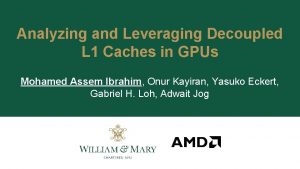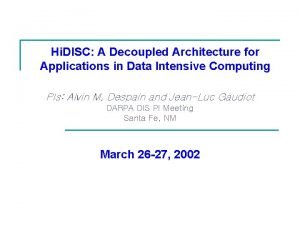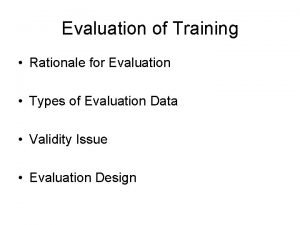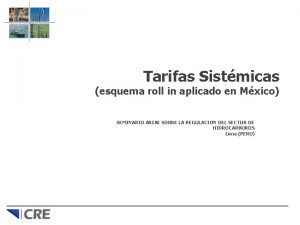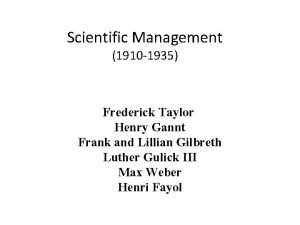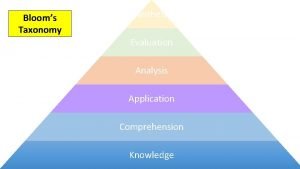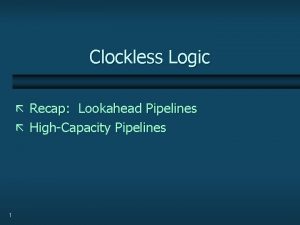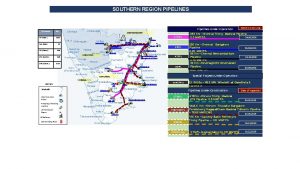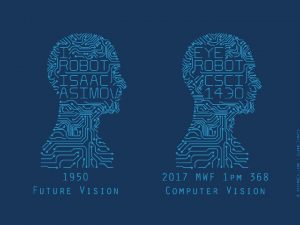Decoupled Pipelines Rationale Analysis and Evaluation Frederick A
































- Slides: 32

Decoupled Pipelines: Rationale, Analysis, and Evaluation Frederick A. Koopmans, Sanjay J. Patel Department of Computer Engineering University of Illinois at Urbana-Champaign

Outline Introduction & Motivation Background DSEP Design Average Case Optimizations Experimental Results 2

Motivation Why Asynchronous? n n No clock skew No clock distribution circuitry Lower power (potentially) Increased modularity But what about performance? n What is the architectural benefit of removing the clock? w Decoupled Pipelines! 3

Motivation Advantages of a Decoupled Pipeline n n n Pipeline achieves average-case performance Rarely taken critical paths no longer affect performance New potential for average-case optimizations 4

Synchronous vs. Decoupled Synchronous Synchronizing mechanism Synchronous Latch clock data Stage 1 Decoupled Stage 2 Asynchronous Communication Protocol Control 1 Stage 1 go data Self-Timing Logic ack Control 2 Stage 3 Elastic Buffer go data ack Control 3 Stage 3 5

Outline Introduction & Motivation Background DSEP Design Average Case Optimizations Experimental Results 6

Self-Timed Logic Bounded Delay Model n n n Definition: event = signal transition start event provided when inputs are available done event produced when outputs are stable w Fixed delay based on critical path analysis n Computational circuit is unchanged Start Input Self-Timing Circuit Computational Circuit Done Output 7

Asynchronous Logic Gates C-gate n logical AND Waits for events to arrive on both inputs XOR-gate n Waits for an event to arrive on either input SEL-gate n logical OR logical DEMUX Routes input event to one of the outputs C X O R S E L 1 0 8

Asynchronous Communication Protocol 2 -Step, Event Triggered, Level Insensitive Protocol n n Transactions are encoded in go / ack events Asynchronously passes instructions between stages go Sender Stage ack data Transaction 1 Transaction 2 go ack data_1 Receiver Stage 1 0 data_2 9

Outline Introduction & Motivation Background DSEP Design Average Case Optimizations Experimental Results 10

DSEP Microarchitecture Decoupled, Self-Timed, Elastic Pipeline At a high-level: From I–Cache Fetch Flush n n Decode R Write back e Rename t Retire i Read/Reorder r e Issue n n n 9 stage dynamic pipeline Multiple instruction issue Multiple functional units Out-of-order execution Looks like Intel P 6 µarch What’s the difference? Results Execute Data Read Commit 11

DSEP Microarchitecture Decoupled, Self-Timed, Elastic Pipeline Decoupled: From I–Cache Fetch Flush n Decode Rename Read/Reorder Write back Retire R e t i r e w Based on local critical path w Stage balancing not important n Execute Data Read Each stage can have several different latencies w Selection based on inputs Issue Results Each stage controls its own latency n Pipeline is operating at several different speeds simultaneously! Commit 12

Pipeline Elasticity Definition: n Pipeline’s ability to stretch with the latency of its instruction stream Global Elasticity n n Provided by reservation stations and reorder buffer Same for synchronous and asynchronous pipelines Fetch n Execute Retire When Execute stalls, the buffers allow Fetch and Retire to keep operating 13

Pipeline Elasticity Local Elasticity From I–Cache Fetch Flush n Decode R Write back e Rename t Retire i Read/Reorder r e Issue Results Execute Data Read n Needed for a completely decoupled pipeline Provided by micropipelines w Variable length queues between stages w Efficient implementation, little overhead w Behave like shock absorbers Commit 14

Outline Introduction & Motivation Background DSEP Design Average Case Optimizations Experimental Results 15

Analysis Synchronous Processor n n Each stage runs at the speed of the worst-case stage running its worst-case operation Designer: Focus on critical paths, stage balancing DSEP n n Each stage runs at the speed of its own average operation Designer: Optimize for most common operation w Fundamental advantage of Decoupled Pipeline 16

Average-Case Optimizations Consider a generic example: n If short op is much more common, throughput is proportional to the select logic Generic Stage Select logic Inputs Short operation Long operation M U X Outputs Designer’s Strategy: n n Implement fine grain latency tuning Avoid latency of untaken paths 17

Average-Case ALU Tune ALU latency to closely match the input operation n n ALU performance is proportional to the average op Computational Circuit is unchanged ALU Self-Timing Circuit Arithmetic Start Inputs S E L X O R Logic Shift Done Compare ALU Computational Circuit Output 18

Average-Case Decoder Tune Decoder latency to match the input instruction n n Common instructions often have simple encodings Prioritize most frequent instructions Decoder Self-Timing Circuit Start Input S E L Format 1 Format 2 Format 3 Decoder Computational Circuit X O R Done Output 19

Average-Case Fetch Alignment Optimize for aligned fetch blocks n If the fetch block is aligned on a cache line, it can skip alignment and masking overhead Optimized Fetch Alignment Aligned? Address n Fetch Inst. Block Align/Mask M U X Fetch Block Optimization is effective when software/hardware alignment optimizations are effective 20

Average-Case Cache Access Optimize for consecutive reads to the same cache line n Allows subsequent references to skip cache access Optimized Cache Access To Same Line? Address Read line from cache Previous line n n M U X Cache Line Effective for small stride access patterns, tight loops in I-Cache Very little overhead for non-consecutive references 21

Average-Case Comparator Optimize for the case that a difference exists in the lower 4 bits of the inputs n 4 -bit comparison is > 50% faster than 32 -bit Optimized Comparator ? Inputs 4 -bit Compare 32 -bit Compare n M U X Output Very effective for iterative loops w Can be extended for tag comparisons 22

Outline Introduction & Motivation Background DSEP Design Average Case Optimizations Experimental Evaluation 23

Simulation Environment VHDL Simulator using Renoir Design Suite n n n MIPS I Instruction set Fetch and Retire Bandwidth = 1 Execute Bandwidth ≤ 4 4 -entry split Instruction Window 64 -entry Reorder Buffer Benchmarks n n BS 50 -element bubble sort MM 10 x 10 integer matrix multiply 24

Two Pipeline Configurations Operation DSEP Latencies Fixed Latencies 100 120 Decode 50/80/120 Rename 80/120/150 120 120 20/40/80/100/ 130/150/360/600 120/360/600 Retire 5/100/150 120 Caches 100 120 Main Memory 960 5 5 Fetch Read Execute Micropipeline Register “Synchronous” Clock Period = 120 time units 25

DSEP Performance Compared Fixed and DSEP configurations DSEP increased performance 28% and 21% for BS and MM respectively Execution Time n 26

Micropipeline Performance Goals: n n Determine the need for local elasticity Determine appropriate lengths of the queues Method: n Evaluate DSEP configurations of form Ax. Bx. C w A Micropipelines in Decode, Rename and Retire w B Micropipelines in Read w C Micropipelines in Execute n All configurations include fixed length instruction window and reorder buffer 27

Micropipeline Performance Measured percent speedup over 1 x 1 x 1 n 2 x 2 x 1 best for both benchmarks w 2. 4% performance improvement for BS, 1. 7% for MM w Stalls in Fetch reduced by 60% for 2 x 2 x 1 Matrix-Multiply Percent Speedup Bubble-Sort 28

OOO Engine Utilization Measured OOO Engine utilization n n Instruction Window (IW) and Reorder Buffer (RB) Utilization = Avg # of instructions in the buffer IW-Utilization up 75%, RB-Utilization up 40% Instruction Window Reorder Buffer Utilization n 29

Total Performance Compared Fixed and DSEP configurations DSEP 2 x 2 x 1 increased performance 29% and 22% for BS and MM respectively Execution Time n 30

Conclusions Decoupled, Self-Timing n n Average-Case optimizations significantly increase performance Rarely taken critical paths no longer matter Elasticity n n n Removes pipeline jitter from decoupled operation Increases utilization of existing resources Not as important as Average-Case Optimizations (At least for our experiments) 31

Questions? 32
 Analyzing and leveraging decoupled l1 caches in gpus
Analyzing and leveraging decoupled l1 caches in gpus Decoupled software architecture
Decoupled software architecture Training rationale sample
Training rationale sample Westwood pipelines
Westwood pipelines Ammonia pipelines
Ammonia pipelines Teppco pipeline map
Teppco pipeline map Tom coolidge
Tom coolidge Edge-to-core-to-cloud data pipelines
Edge-to-core-to-cloud data pipelines Pipelines
Pipelines Learning to read and write frederick douglass analysis
Learning to read and write frederick douglass analysis Rationale
Rationale Frederick taylor and frank and lillian gilbreth
Frederick taylor and frank and lillian gilbreth Frederick douglass and harriet jacobs
Frederick douglass and harriet jacobs Frederick twort and felix d'herelle
Frederick twort and felix d'herelle Rationale statement example
Rationale statement example Justification and rationale
Justification and rationale Background and rationale
Background and rationale Knowledge comprehension application analysis
Knowledge comprehension application analysis Project analysis and evaluation
Project analysis and evaluation Reading for understanding analysis and evaluation
Reading for understanding analysis and evaluation Don alden adams
Don alden adams Teoria de taylor
Teoria de taylor William frederick harris
William frederick harris Gwendolyn oscar wilde
Gwendolyn oscar wilde Tim fredrick
Tim fredrick Ejemplos de eficasia
Ejemplos de eficasia Criticas a la teoria cientifica de la administracion
Criticas a la teoria cientifica de la administracion In morse v frederick what was the question at stake
In morse v frederick what was the question at stake Taylor management theory
Taylor management theory Frederick c branch scholarship
Frederick c branch scholarship Who is private ryan in real life
Who is private ryan in real life Frederick perls
Frederick perls Frederick banting facts
Frederick banting facts
